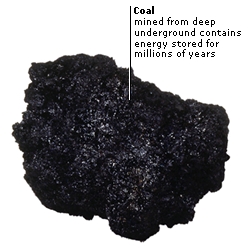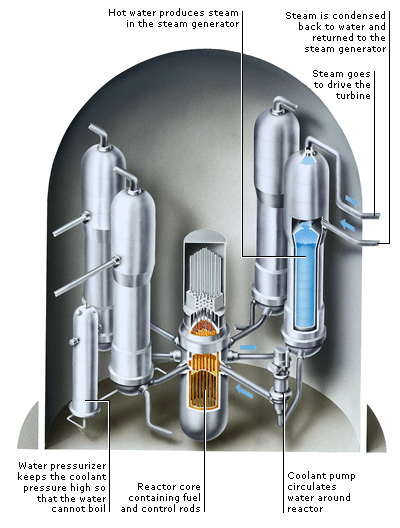DK Science: Energy Sources
Everything we do takes energy, which we get from many different sources. Most of the energy on Earth originally came as light and heat from the Sun. It has been stored in fuels such as coal and oil, formed from the fossilized remains of plants or animals over millions of years. Supplies of these fossil fuels are limited. This is why we are now turning to supplies of RENEWABLE ENERGY that never run out. Another alternative is GEOTHERMAL ENERGY, produced deep inside the Earth.

This power station is burning coal to release the chemical energy it contains and produce electricity. The Sun’s energy is converted into carbon-based compounds by plants as they grow. When plants decay, they change into a dark, earthlike substance called peat. Over millions of years, the peat is buried under other material and pressure turns it into coal.
Every second, the same amount of energy reaches Earth from the Sun as a coal-fired power station could make from about 200,000 truckloads of coal. The Sun makes energy from nuclear reactions deep inside it. In some ways it is like a giant nuclear power station.
Nuclear reactions take place in the fission reactor of a nuclear power station. Coolant (cold water) is pumped around the reactor and is turned to steam by the heat generated by the reactions. The steam drives an electricity-generating machine called a turbine.
Long after fossil fuels have run out, the tides will still be turning, the wind will still be blowing, and the Sun will still be shining. Ocean, wind, and solar power is called renewable energy because it never runs out. Using renewable energy is better for the environment. Unlike fossil fuels, it produces no harmful pollution and does not add to the problem of global warming.

A solar panel can be made up of many small solar photovoltaic cells. A photovoltaic cell is an electronic device that converts light into electricity. When sunlight falls on the cell, it makes electrons move from one layer of the cell to the other. The movement of electrons makes electricity flow through the cell, and out through wires to be used or collected in a battery.

As the tides ebb and flow, they make water move back and forth in rivers that end in estuaries at the coast. A tidal power generator is a type of bridge that blocks the mouth of an estuary so the tide has to move through it. Each time the water flows in or out, it turns a turbine inside the power generator and produces electricity.
This form of energy is not generated by the Sun. It is made by the nuclear reactions taking place all the time deep inside the Earth. These make heat energy in the Earth’s core, and the heat moves around inside the Earth by convection. Volcanoes and hot geysers release geothermal energy at the Earth’s surface.
A geothermal energy plant takes its power from the Earth’s heat. It works by pumping cold water down a hole drilled into the Earth. The Earth’s geothermal energy heats up the water and it returns to the surface as hot water and steam. The hot water can be pumped to homes and factories nearby. The steam is used to drive a turbine and make electricity.

